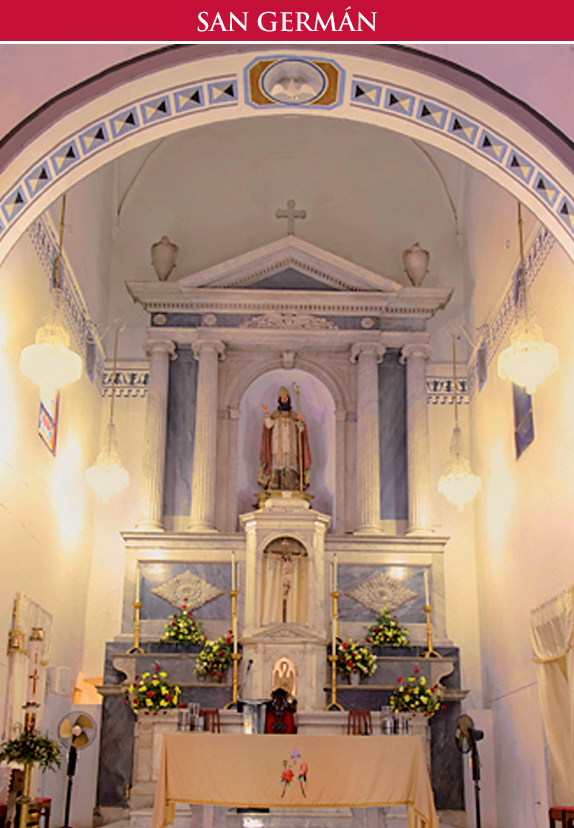
San German
This quaint hillside town, known locally as “Ciudad de las Lomas” (City of the Hills), was founded in 1573 and boasts the island’s most intact colonial core outside Old San Juan. Its leafy plazas are surrounded by exquisite colonial buildings in eclectic architectural styles – reminders of the wealth generated by the 19th-century coffee boom. In all, the 36-acre (15-ha) historic core has 249 buildings listed on the National Register of Historic Places, including a 400-year-old church, Iglesia Porta Coeli, containing the nation’s most important religious art museum. The town is named after Germaine de Foix, the second wife of King Ferdinand of Spain.
 San German Tourism and Culture Office • Interamerican University Avenue • 787 892 3790 • open 8am–4pm Mon–Fri
San German Tourism and Culture Office • Interamerican University Avenue • 787 892 3790 • open 8am–4pm Mon–Fri
1. Plaza Santo Domingo
The elongated Plaza Santo Domingo, once a marketplace, is paved with red brick and lined with historic buildings and attractively restored, Victorian-inspired, 19th-century mansions.
2. Iglesia Porta Coeli
The simple Spanish-mission style “Heaven’s Gate” church dates from 1606 and stands atop a stepped, red-bricked pedestal. Originally a monastery, it was fortified to guard against pirates.
3. Porta Coeli Religious Art Museum
The Museo de Arte Religioso, within the Iglesia Porta Coeli, exhibits religious statuary, precious paintings, and the nation’s largest collection of santos (statues of saints) (for further details see Porta Coeli Religious Art Museum).
4. Casa Morales
The Victorian-inspired photogenic Casa Morales, a private residence built in 1898, stands on a corner of Plaza Santo Domingo. Its design reflects the US influence on the island. Casa Morales • Calle Ramos 38
Casa Morales • Calle Ramos 38
5. Plaza Francisco Mariano Quinones
This oblong square, a popular spot for locals to gather and gossip, features topiary and is graced by wrought-iron benches and an 18th-century church.
6. Casa Lola Rodriguez de Tio
Built in the 17th century, this mansion was occupied by family members of explorer Ponce de León (for further details see San Juan Founded), and by patriot-poet Lola Rodríguez de Tió (1843–1924), who designed the Puerto Rican flag. Casa Lola Rodríguez de Tió • Calle Dr Santiago Veve 13
Casa Lola Rodríguez de Tió • Calle Dr Santiago Veve 13
7. Iglesia de San German de Auxerre
This Neo-Classical church, which rises over Plaza Francisco Mariano Quiñones, was completed in 1848. It boasts an impressive crystal chandelier and trompe l’oeil. Iglesia de San German de Auxerre • Plaza Francisco Mariano Quiñones • 787 892 1027
Iglesia de San German de Auxerre • Plaza Francisco Mariano Quiñones • 787 892 1027
8. Evening Paseo
Locals gather at dusk to promenade along the town’s twin plazas, both of which have cobblestone streets and shady trees that lend San Germán a romantic yesteryear air.
9. Casa Acosta y Fores
Considered one of the most beautiful homes in Puerto Rico, this mansion exemplifies the island’s Art Nouveau architecture era with its Victorian-inspired elements. Casa Acosta y Fores • Calle Dr Santiago Veve 70
Casa Acosta y Fores • Calle Dr Santiago Veve 70
10. Casa Juan Ortiz Perichi
Built in 1920, this home, which is one block south of Plaza Santo Domingo, is a classic example of ornamental architecture and features elegantly curved balconies and a pitched roof. Casa Juan Ortíz Perichi • Calle Luna 94
Casa Juan Ortíz Perichi • Calle Luna 94
Pirate Past
Supposedly, many of San Germán’s wealthy inhabitants derived their income as pirates, or as wreckers who lured ships onto the rocks, although this is more apocryphal than fact. The township was founded in 1511 at the mouth of the Río Guaorabo, but attacks by French corsairs in 1528, 1538, and 1554 forced the residents to re-establish their town at the present site.
 Tip: Wear good walking shoes and carry water – the town is hilly and exploring the streets can be very hard work.
Tip: Wear good walking shoes and carry water – the town is hilly and exploring the streets can be very hard work. Tip: The town’s Mike’s Steak House is a good place to dine on some excellent chargrilled steak and seafood.
Tip: The town’s Mike’s Steak House is a good place to dine on some excellent chargrilled steak and seafood.


